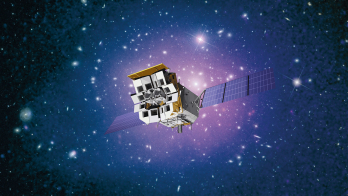Observations of very high-energy gamma-rays from two distant active galaxies reveal that the universe is more transparent to this radiation than previously thought. This limited absorption of gamma-rays en route to Earth implies that the fog of light in intergalactic space is dominated by emissions from stars in galaxies that have already formed, rather than from the first generation of stars, which would have shone before galaxy formation.

Gamma-rays at tera-electron-volt energies can produce electron-positron pairs when they interact with visible light. These very high-energy gamma-rays can therefore be absorbed when travelling through intergalactic space filled with photons from the accumulated starlight emitted by galaxies throughout the history of the universe, as well as from other possible sources such as quasars and the very first generation of stars.
The direct detection of this extragalactic background light is made difficult because of our light-polluted environment, in particular by zodiacal light – sunlight reflected from dust clouds in our solar system. An indirect method consists of deriving this background radiation based on its opacity to tera-electron-volt gamma-rays. This can now be achieved for the first time thanks to the high sensitivity of the four Cherenkov telescopes of the High Energy Stereoscopic System (HESS) (see CERN Courier January/February 2005 p30).
HESS has observed tera-electron-volt gamma-rays from two relatively distant active galaxies at redshifts of z = 0.165 and 0.186. These objects are most likely blazars, similar to Mkn 421 and Mkn 501, two nearby (z ∼ 0.03) tera-electron-volt gamma-ray sources. The observed radiation of blazars is thought to be amplified and shifted towards higher energies because it is emitted in a relativistic jet towards us. Observations of blazars as well as theoretical shock-acceleration models in jets show that the gamma-ray spectral slope cannot be harder than Γ = 1.5. Using this property and the fact that the opacity through electron-positron pair production is energy dependent, the HESS collaboration has been able to set a firm upper limit on the absorption of gamma-ray photons and hence on the amount of extragalactic background light.
This limit is less than – and hence in conflict with – the values derived by direct measurements of the extragalactic background light. Furthermore, being only about a factor of 1.5 above the lower limit given by direct observation of galaxies by the Hubble Space Telescope, the HESS observations seriously limit the possible contribution from sources other than galaxies. This is in good agreement with recent theoretical calculations and arguments against a strong extragalactic background from first-generation stars. This is bad news for the attempts at direct detection of the glow of these population III stars (see CERN Courier December 2005 p10), but the HESS results expand the horizon of the gamma-ray universe, allowing Cherenkov telescopes to detect many other remote active galaxies.
Further reading
F Aharonian et al. 2006 Nature 440 1018.








